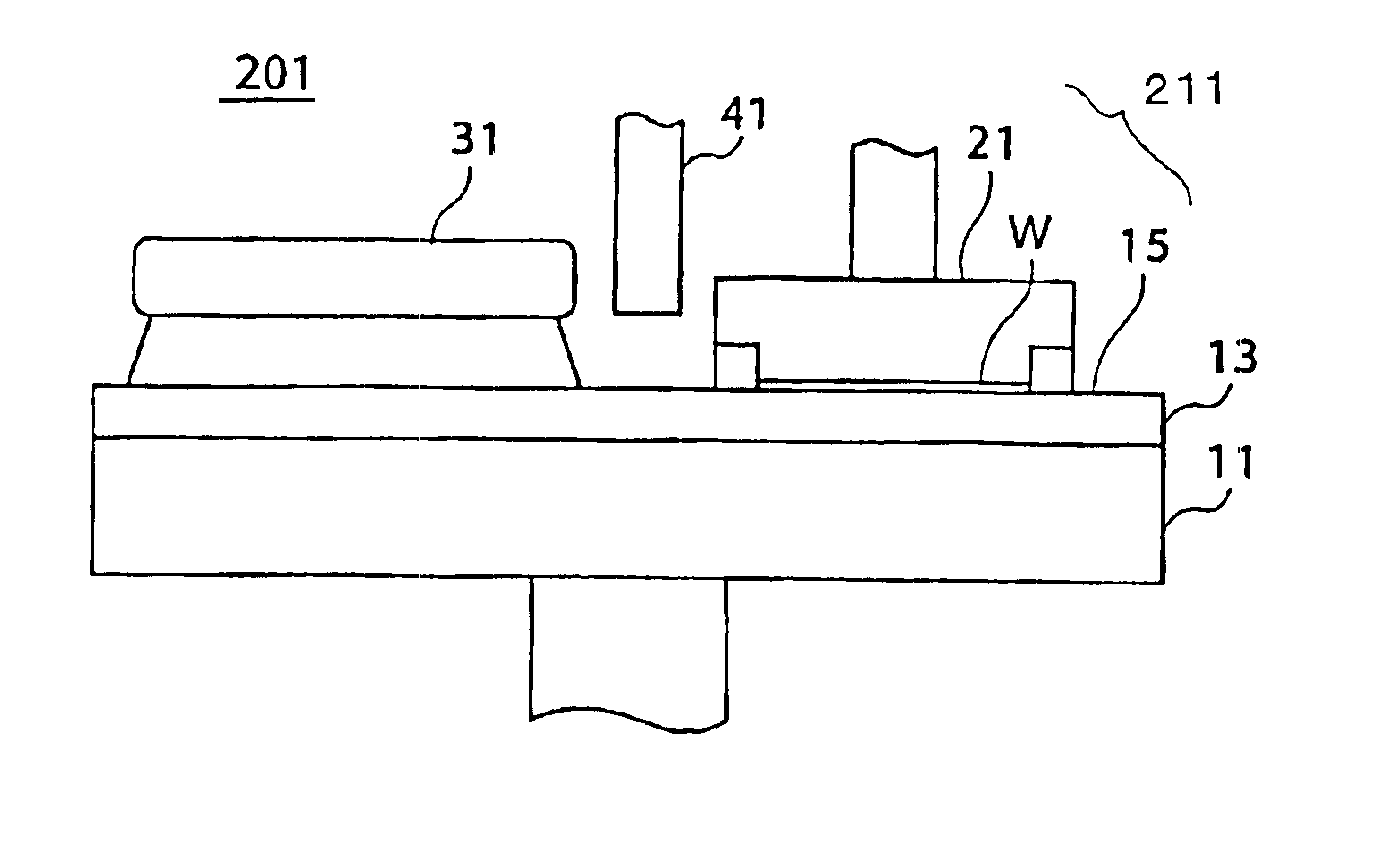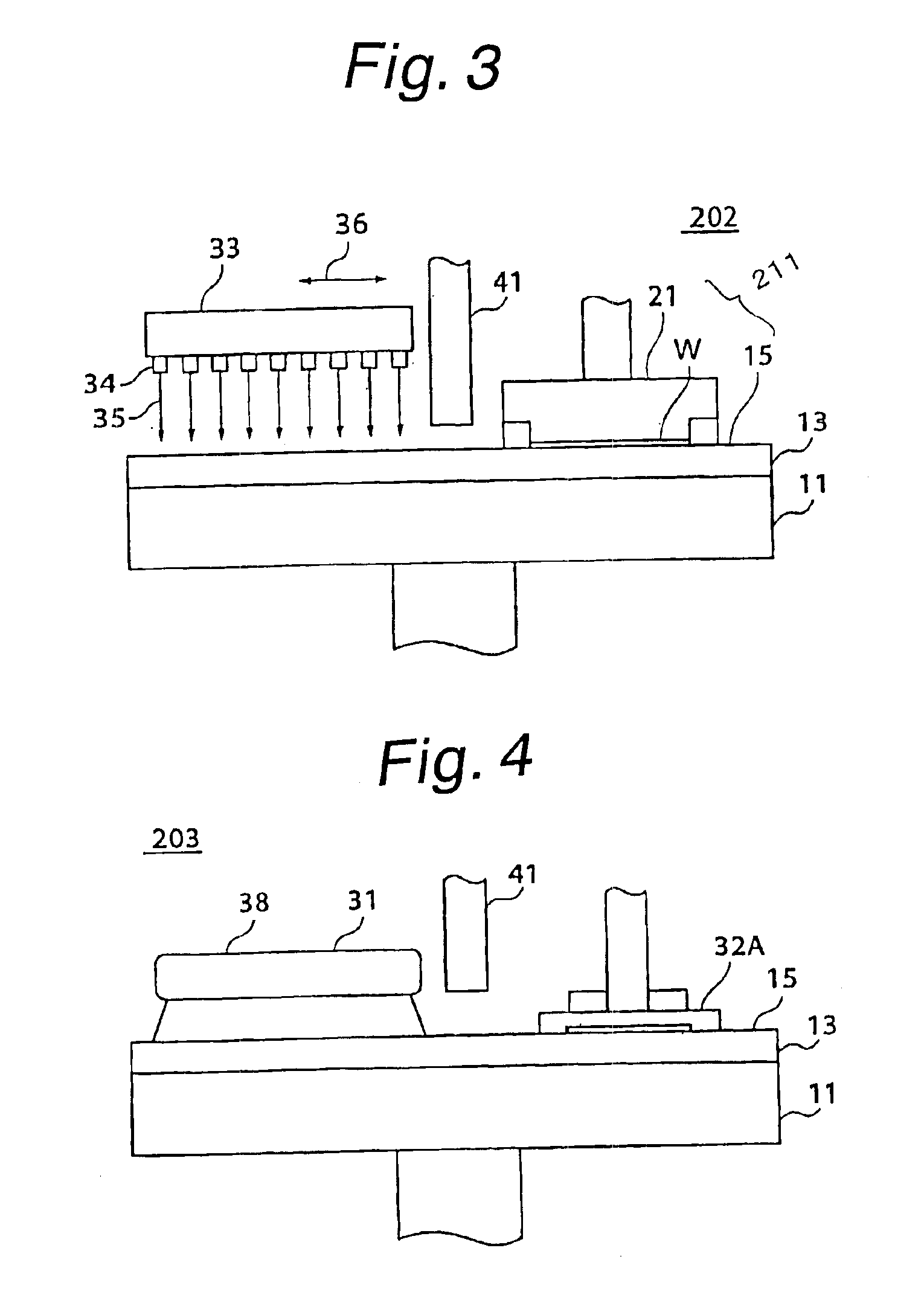Polishing apparatus and dressing method for polishing tool
a technology of polishing apparatus and dressing method, which is applied in the direction of manufacturing tools, lapping machines, and abrasive surface conditioning devices, etc., can solve the problems of unstable polishing rate, reduced throughput, and gradual reduction of polishing rate, so as to achieve satisfactory dressing, enhance the effect of dressing, and improve the effect of dressing
- Summary
- Abstract
- Description
- Claims
- Application Information
AI Technical Summary
Benefits of technology
Problems solved by technology
Method used
Image
Examples
first embodiment
[0046]FIG. 1 is a schematic front view showing a polishing apparatus 201 according to the present invention. The polishing apparatus 201 has a rotating turntable 11 and a fixed abrasive 13 provided on the turntable 11. In this embodiment, the fixed abrasive 13 constituting a polishing tool is formed by including abrasive particles (not shown) and a binder (not shown) for fixing (bonding) together the abrasive particles.
[0047]Examples of substances usable as materials for the abrasive particles of the fixed abrasive 13 are silicon oxide (SiO2), alumina (Al2O3), cerium oxide (CeO2), silicon carbide (SiC), zirconia (ZrO), iron oxides (FeO, Fe3O4), manganese oxides (MnO2, Mn2O3), magnesium oxide (MgO), calcium oxide (CaO), barium oxide (BaO), zinc oxide (ZnO), barium carbonate (BaCO3), diamond (C) and titanium oxide (TiO2).
[0048]Examples of usable binder materials are thermosetting resins such as epoxies (EP), phenols (PF), ureas (UF), melamines (MF), unsaturated polyesters (UP), silico...
second embodiment
[0055]FIG. 3 is a schematic front view showing a polishing apparatus 202 according to the present invention. In the polishing apparatus 202, a laser source 33 is used as a light source to apply laser beams to fixed abrasive 13. The laser source 33 has a large number of laser beam outlets 34 to apply laser beams 35 thoroughly to an irradiated part (polishing surface 15) of the fixed abrasive 13 (with a circular planar configuration). The laser source 33 is capable of oscillating in directions indicated by double-headed arrow 36 in the figure (in horizontal directions parallel to a radial direction of the polishing surface 15). Thus, it is possible to avoid local concentration of laser beams 35 and, at the same time, possible to provide a high energy density to a surface (polishing surface 15) of the fixed abrasive 13 by irradiation with intense laser beams 35. Accordingly, free abrasive particles can be generated efficiently from the fixed abrasive. That is, a dressing effect can be ...
third embodiment
[0084]FIG. 4 shows a polishing apparatus 203 having a dresser 32A including diamond particles as a waste matter removing device according to the present invention. The polishing apparatus 203 includes a dressing mechanism 38 having a light source 31 to perform dressing by light irradiation. In the polishing apparatus 203, waste matter unrelated to polishing, including the above-described incompletely dissolved resin, can be scraped off or eliminated by pressing the dresser 32A against polishing surface 15 of fixed abrasive 13. Thus, polishing abrasive particles can be exposed even more effectively, and hence efficient polishing can be realized. Further, if the incompletely dissolved resin is scraped off, a surface condition that is at least homogeneous can be reproduced on the polishing surface 15. Thus, it is possible to maintain a uniform surface condition.
PUM
| Property | Measurement | Unit |
|---|---|---|
| pressure | aaaaa | aaaaa |
| bond energies | aaaaa | aaaaa |
| bond energies | aaaaa | aaaaa |
Abstract
Description
Claims
Application Information
 Login to View More
Login to View More - R&D
- Intellectual Property
- Life Sciences
- Materials
- Tech Scout
- Unparalleled Data Quality
- Higher Quality Content
- 60% Fewer Hallucinations
Browse by: Latest US Patents, China's latest patents, Technical Efficacy Thesaurus, Application Domain, Technology Topic, Popular Technical Reports.
© 2025 PatSnap. All rights reserved.Legal|Privacy policy|Modern Slavery Act Transparency Statement|Sitemap|About US| Contact US: help@patsnap.com



